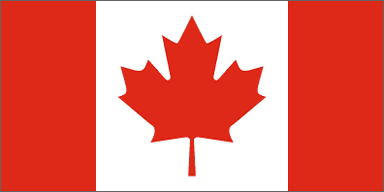
The Canadian National Flag.

The Canadian National Flag was adopted by the Canadian Parliament on 22 October 1964 after much heated debate (as is normal in Canada) with a two-thirds majority and was proclaimed into law by Her Majesty Queen Elizabeth II (the Queen of Canada) on 15 February 1965. The Canadian Flag (colloquially known as The Maple Leaf Flag) is a red flag of the proportions two by length and one by width, containing in its centre a white square, with a single red stylized eleven-point maple leaf centred in the white square. The colours red and white used in the Canadian flag are the same as those colours used in the Union Flag of the United Kingdom.
The Pearson Liberals had been planning this flag for some time intending for it to become as much a red Liberal Party symbol as a National Flag. It was designed by an advertising agency connected to the Liberal Party and dyed a Liberal rouge. According to the Liberal claims at the time, the flag was intended to represent ALL of Canada - a spendid symbol of the new bilingual, bi(multi?)cultural country Lester B. Pearson hoped to build.
It is not generally known by today's generation that this was Canada's first and only CANADIAN flag. In the distant past Canadians had flown the historic British Union Jack:

And then the Red Ensign came to represent Canada but this was technically just a banner not a national flag.
In 1924 the Canadian Government modified the design of the Ensign to place the shield of the Arms of Canada on the fly. This shield was divided into five sections. The top two-thirds of the Shield contained the "quartered" Lions of England (gold on red), Lion of Scotland (red on gold), Harp of Ireland (gold on blue), and three fleur-de-lis of France (gold on blue); on the bottom third of the shield was a sprig of three maple leaves (red on white).

It was under the Red Ensign that Canadians stormed the beaches of Normandy and fought their way up the boot of Italy all the way to Berlin. The Red Ensign represented Canada at its best.
In the early sixties, the Liberals, in their rush to ensure Canadians had an all red banner, failed to take into consideration the blue of the fleur-de-lis of the Province of Québec:

So, accepting the reality of the flag from the sixties, it would make more sense to have a "banner" such as the one below which surely looks far more attractive to a much broader segment of present day Canadian society:

In addition, it is generally accepted, that in the Heraldic field, Red represents Valour and Strength, White - Purity and Innocence and Blue - Perseverance and Justice. In total, not bad qualities to aspire to!
|

| The "Holmestead" is located at: |
| 140 Thunder Beach Road, 17th Concession, Township of Tiny, |
| ONTARIO, L9M 0T3, CANADA |
|

